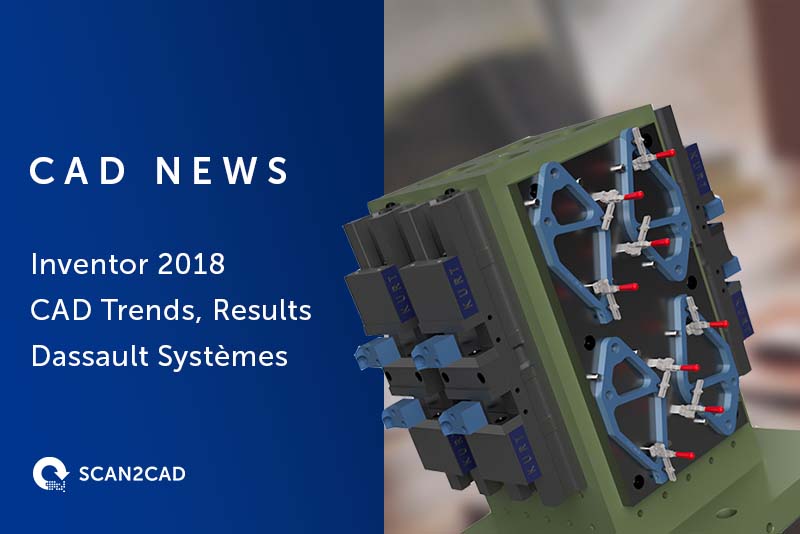Welcome to the twelfth edition of World of CAD, Scan2CAD’s monthly roundup of CAD-related news. In this edition, we’ll start by looking closely at the results of Business Advantage’s CAD Trends 2016 survey. Also under the microscope are the new version of Autodesk Inventor, and the possibility of a groundbreaking new business model from Dassault Systèmes.
In hardware, we’ll cover a new CNC mill with a footprint the size of an A4 piece of paper. Finally, we’ll cover an engraving project you can even try yourself, and that might just bring a few memories back. Read on for the full details!
CAD Trends 2016: The results
Last year, we reported on some insights from Business Advantage’s CAD Trends report. Compiled each year, CAD Trends aims to provide a snapshot of how CAD software is being used across a range of different industries, and to help provide developers with a better idea of how to improve their software for customers. In March, Business Advantage unveiled the results of its latest survey: CAD Trends 2016.
The survey revealed some of the most popular CAD tools on the market; it should come as little surprise to find out that AutoCAD came top, followed by SolidWorks. Indeed, the traditional software categories of 3D modelling and 2D drafting remained the most important for CAD businesses—well ahead of new technologies such as AR/VR and cloud-based CAD. Nonetheless, cloud-based CAD and CAD mobile apps show some of the strongest potential for growth, alongside 3D printing.
CAD Trends additionally showed that users took just over two months to break even, in productivity terms, after switching to an upgraded software version. It also revealed an increase in the number of users downloading 3D CAD models. For more information and the full PDF, head to Business Advantage.

Autodesk unveils Inventor 2018
Earlier this month, we wrote about the long-awaited launch of AutoCAD 2018. However, this was to be far from the only new product announcement from CAD powerhouse Autodesk. In another annual update to a key piece of Autodesk software, March 28th saw the unveiling of Inventor 2018.
Inventor is Autodesk’s flagship 3D modelling software, standing in direct competition with SolidWorks and Solid Edge. Already boasting a healthy set of features, Inventor has seen its capabilities grow with the release of the 2018 edition. Key sets of new tools come in the fields of model-based design (MBD) and model-based engineering (MBE), which are now becoming standard across the engineering industry. These new tools enable users to annotate models with tolerance information, critical dimensions, and manufacturing notes.
Additionally, Inventor 2018 includes support for more file types than ever before, and also allows for backward compatibility. The software also offers faster assemblies with quicker rendering, plus a more intuitive interface which is easier to navigate and requires less clicking around. There’s a strong focus on consumer-friendly enhancements, including a simplified Measure tool and better compatibility with Revit. Learn more at Autodesk’s Inventor 2018 page, or check out the video below.
A new business model for Dassault Systèmes?
April 4-5 saw the Milano Congressi hosting Dassault Systèmes’ worldwide user conference: Design in the Age of Experience. Addressing the attendees, the Dassault Systèmes’s CEO Bernard Charlès reaffirmed his commitment to the company’s 3DEXPERIENCE approach. He claimed that businesses as a whole “are over capacity… under-innovate, and… don’t provide enough value to society”, whilst Dassault Systèmes “want to change that equation”. One of the most intriguing ways in which the company may be shaking things up is in the introduction of a radical new business model.
The foundation of that business model? Paying not for the software you use, but instead for what you create using it. Executive Vice President Pascal Daloz used the example of the company’s 3DPrinting Marketplace, but stated that “it’s not limited to 3D printing”. He even claimed that the company “could go so far as give the software for free, if we find a way to do that”.
In L’Usine nouvelle, Daloz explained how the system could work: “If you don’t have Catia, you go to our marketplace and you work on Catia in your browser, and you aren’t charged for it. What you buy is the result of that work in Catia”. The end goal is to “disrupt the world of software”—including Dassault Systèmes themselves.
Will this idea become reality? Daloz gave no date, but merely said that “it’s happening; we’re moving forward step by step”. We’ll certainly be keeping a close eye on it here at the Scan2CAD blog.
Short on space? This is the CNC mill for you
In our recent article comparing the different types of CNC machine, we noted that CNC routers and mills typically feature quite large workspaces. However, one machine turning that idea on its head is the MicroMill. This machine features possibly the smallest footprint we’ve ever seen in a CNC mill—around the size of an A4 sheet of paper. Naturally, this machine isn’t suitable for any particularly expansive projects you had in mind, but its 115 (Y) x 100 (X) x 64 (Z) workspace is great for smaller pieces.
The Dorset, England-based RP3d team who created the MicroMill said that the inspiration for the machine came out of necessity. “[We] had… an inability to produce high quality, usable parts in house. The other machines on the market were simply too expensive for what they offered,” the team notes. Realising they weren’t the only ones facing this problem, they decided to create their own mill. The aim? 4-figure function and performance with a 3-figure price tag.
Don’t be fooled by the MicroMill’s diminutive size: it can machine almost any material softer than steel. The mill itself features high performance parts, thanks to RP3d’s partnership with German firm Igus. It supports practically any CAM program on the market, and runs off the GRBL open-source platform. In addition to these advantages, RP3d boast of the MicroMill’s versatility, light weight, and ease of use.
To support the MicroMill project, or just to learn more, check it out on Kickstarter.
Grade school techniques get a laser engraving upgrade
As kids, many of us will remember using a magnifying glass to focus the sun’s rays and—hopefully—starting a small fire. You may, however, be wondering what exactly this has to do with engraving. Well, Instructables user rabbitcreek has created a fantastic tutorial showing how to apply those same principles to a creative new CNC engraver.
Despite its unique concept, this machine is more sophisticated than you may be expecting, with materials including a large Fresnel lens, an Arduino-compatible board, and a 2 axis joystick. It also uses a metal plate to act as a shutter, helping you to control the target and prevent fires. When assembled, the machine harnesses the sun’s rays, enabling you to engrave patterns into wood, alongside other materials.
A note of caution, though: creator rabbitcreek warns that this project can be somewhat unpredictable. “The first thing was [that] it caught fire”, he recalls. So, if you do decide to attempt this project yourself, then make sure to take proper precautions!

